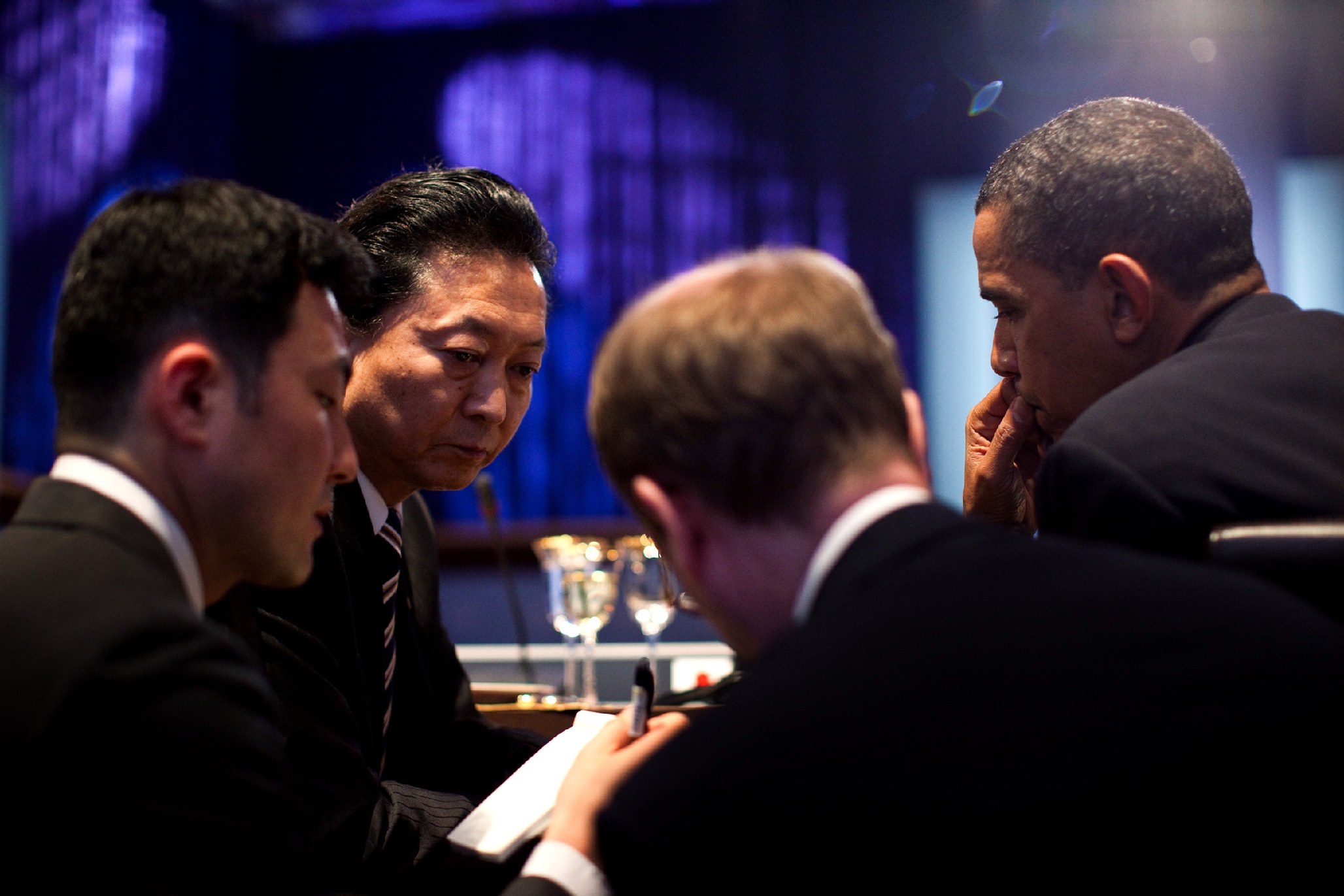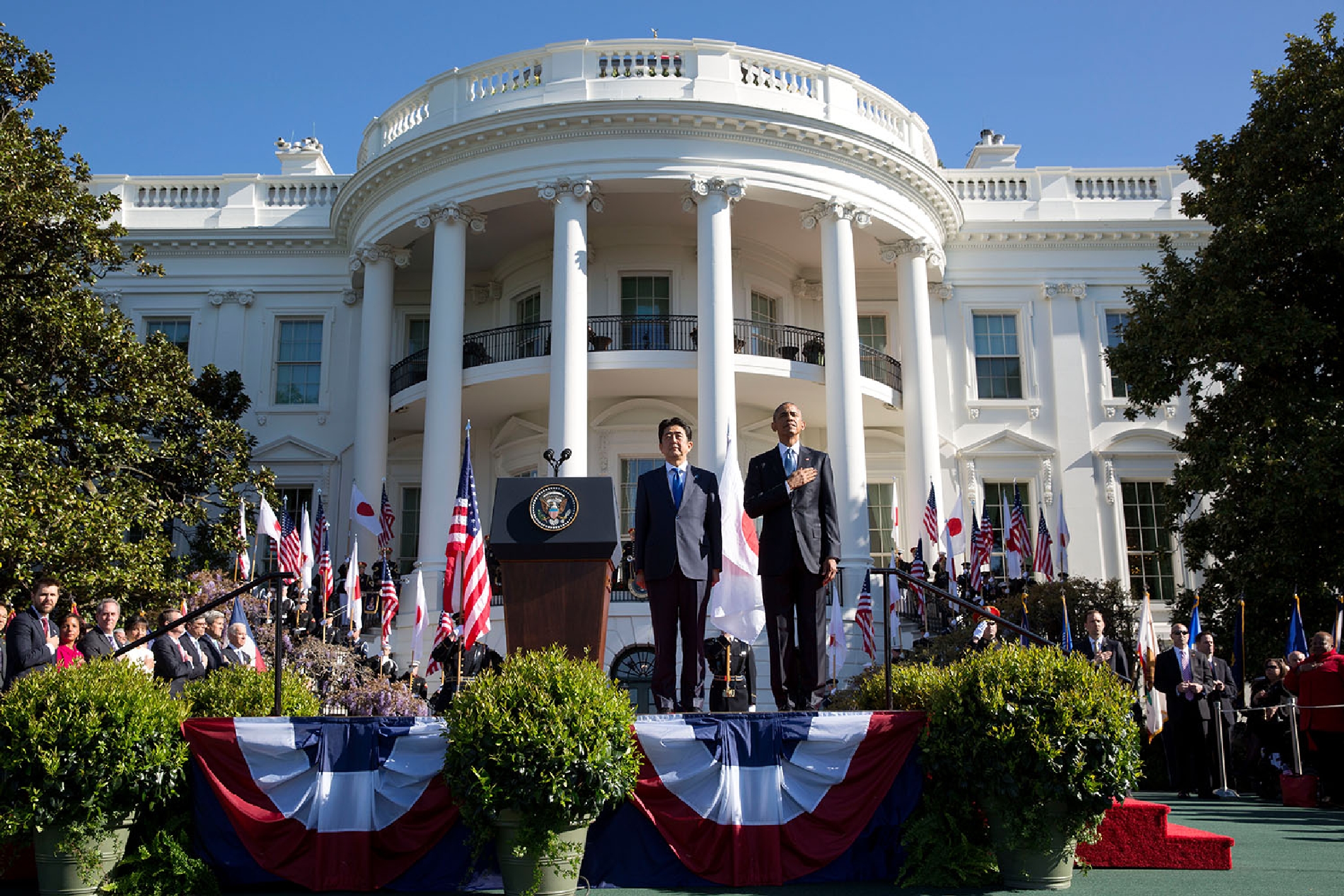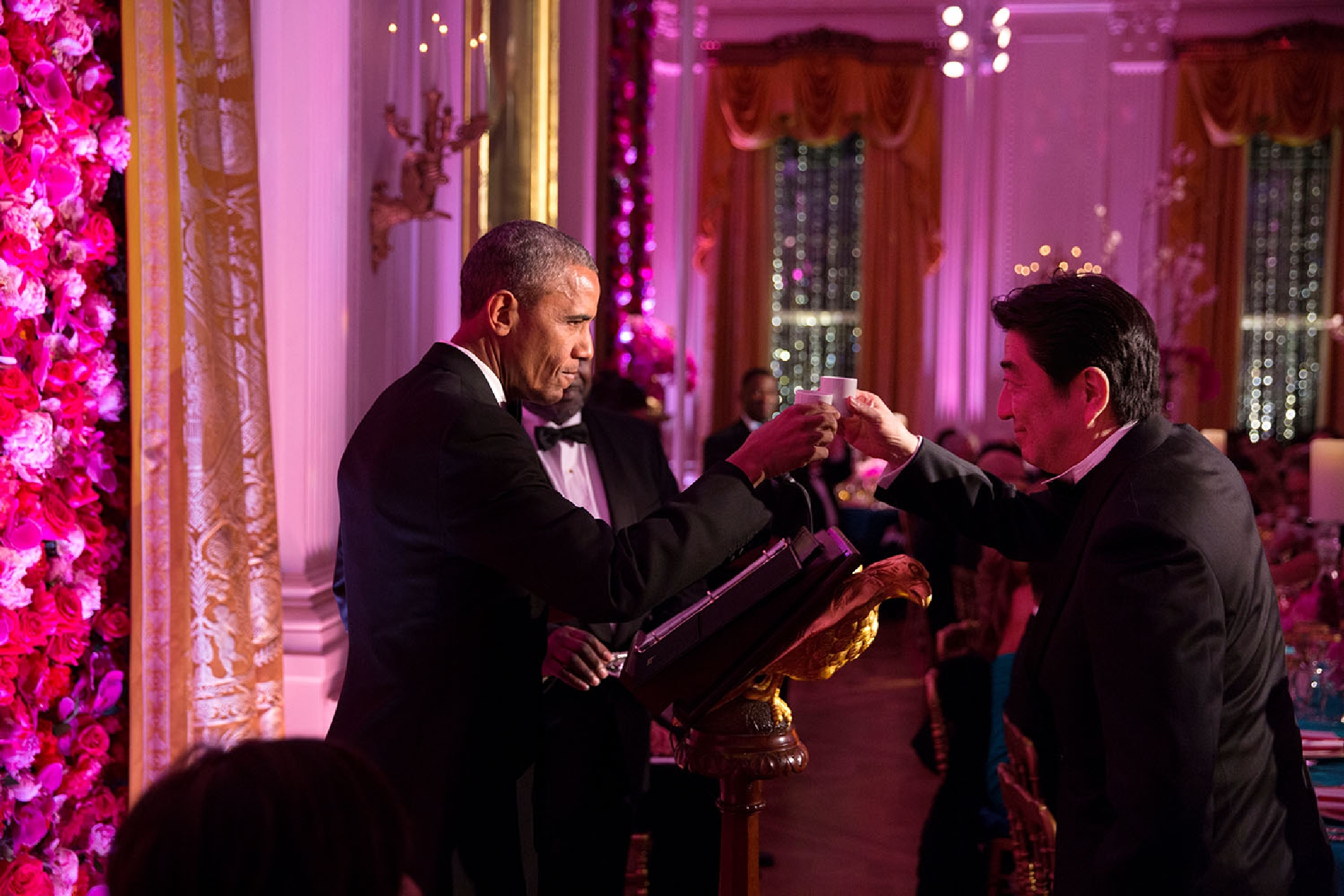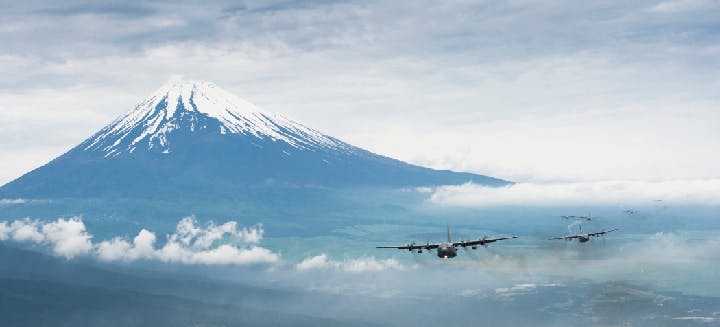Winter 2016
Japan, the United States, and a changed Pacific
– Ellis S. Krauss
Obama’s “pivot to Asia” has been matched by Japan’s own pivot to America.
In 2009, just months after Barack Obama took office, Japanese politics and U.S.-Japan relations were on the verge of a seismic shakeup. That August, the center-left Democratic Party of Japan (DPJ) swept Japan’s conservative Liberal Democratic Party (LDP) — which had governed the country continuously since 1955, with just a single 10-month interruption — from power. For the first time, it looked as though Japan would shift away from its longstanding alliance with American power, and instead warm up to a newly ascendant China.
Now, as Obama’s second term is ending, both Japan’s domestic politics and its relationship with the United States have turned around completely. U.S.-Japan relations have never looked more positive. President Obama’s “pivot” to Asia was matched by Japan’s own pivot to America.
Obama’s pivot to Asia was matched by Japan’s own pivot to America

2009–2012: The sudden rise and endless fall of the DPJ
Ahead of the DPJ’s historic landslide parliamentary victory on August 30, 2009, Yukio Hatoyama, then the party’s leader and soon to be its first prime minister, had broached a sensitive issue: He proposed relocating the large American military on Okinawa, moving it from Futenma in the island’s crowded south up to its relatively unpopulated north. In truth, this position was not much of a contrast from that held by the sitting LDP-led government — which, after a decade of difficult negotiations, had already struck an agreement with the United States to move the base — but raising it as an election issue might have signaled a willingness to publicly distance Japan from its Western ally.
After the DPJ won power that August, Prime Minister Hatoyama took a further step: he demanded the U.S. base on Okinawa close completely, a position that forced another six months of bilateral talks on the question — negotiations in which he had no leverage. The prime minister’s stated goal was a political impossibility and unpopular with the Japanese electorate, which sympathized with Okinawans’ desire to move the base but refused to consider a new U.S. air base anywhere in Japan.
At roughly the same time, the DPJ government decided to end Japan’s policy of refueling and resupplying U.S.-allied ships as they traversed the Indian Ocean en route to support coalition efforts in Afghanistan. Because Japan’s “peace constitution” prevents Tokyo from contributing to any combat missions, the LDP government had established the ship supply policy as a way to make a constitutionally allowed, noncombatant contribution to President George W. Bush’s War on Terror. The DPJ’s cancellation of this program threatened to cool relations with Washington even more. To stave off any further hostility, Japan’s government donated $5 billion to support the rebuilding of Afghanistan’s infrastructure.
This rift between the United States and Japan was not limited to military issues. Hatoyama’s support for an “Asia-Pacific Community,” modeled after the European Union, tugged Japan a bit further from America’s orbit. And shortly after he took office as prime minister, one of Hatoyama’s first moves was to send a huge delegation, including DPJ Diet members, to Beijing. Chinese president Xi Jinping, pleased by the overtures, visited Japan soon thereafter.
The tilt toward China, the attempt to renegotiate the Okinawan military base deal, the withdrawal of support for U.S. ships in the Indian Ocean, the emphasis on a “Pacific community” — all of it irritated Washington. Some observers even saw it as the beginning of the end for the U.S.-Japan alliance. It wasn’t, of course: the DPJ liked and profited from the alliance as much as their predecessors had, and never questioned the joint U.S.-Japan Ballistic Missile Defense that the LDP had pushed for a decade. The blips in Japan’s foreign policy were in fact just a partial readjustment within Japan’s existing post–Cold War “dual hedge” policy: use closer political and economic ties with China and Asia as a hedge against U.S. dominance; use the U.S.-Japan military alliance as a hedge against China and a rogue North Korea.
Japan has long relied on a “dual hedge” policy: using closer political and economic ties with China and Asia as a hedge against U.S. dominance, and using the U.S.-Japan alliance as a hedge against China and North Korea.
The DPJ’s problem was that none of their projects worked, and the silliness of irritating Japan’s greatest ally for nothing — coupled with the failure of the DPJ’s domestic agenda — was not lost on Japanese voters. The Hatoyama administration’s popularity began to sag, and then sank altogether. After less than a year in office, the prime minister and another major DPJ leader were caught in a financial scandal. With his support plummeting, Hatoyama resigned, and the DPJ selected its next prime minister.
Hatoyama’s successor, Naoto Kan, came into office as a highly regarded, straight-talking politician — a citizen activist, a founder of his party, and a popular former health minister. He won immediate acclaim for his candor and honesty during the trial of his predecessor, the disgraced Hatoyama. But for all that the voters loved him, Kan had terrible timing: A scant four months after he took office, a territorial dispute erupted in the East China Sea, where uninhabited islands, called the Senkaku Chain by Japan and the Diaoyu by China, had been claimed by both nations as well as by Taiwan.
The three pretenders to the Senkaku Chain had always managed previous incidents carefully. But in early September 2010, a Chinese fishing boat intentionally rammed a Japanese patrol vessel that had ordered the fishermen out of Japanese waters. At first, Tokyo downplayed the incident, simply arresting the Chinese captain and his crew. China claimed that holding onto the captain was a violation of an informal agreement between the two countries. Beijing’s mood soured. Four Japanese businessmen in China found themselves temporarily detained, and exports of rare-earth metals necessary for the manufacturing of high-tech devices, an essential component of Japan’s economy, were reduced suddenly and sharply. The Chinese claimed that these actions were unrelated to the fishing boat incident, but the rest of the world saw the detention as retaliation for the Senkaku/Diaoyu dispute. Across China, large anti-Japan protests broke out — possibly encouraged (and certainly not denounced) by the government. When Japan finally released the Chinese captain, he came home to enormous fanfare, hailed as a hero. Soon after, a video of the ramming incident emerged, clearly showing that the Chinese fishing vessel was at fault. The Japanese government had tried to keep this footage out of public sight for fear of further alienating China. When the video went viral, Japan’s government came across as deceptive and manipulative for withholding this information from the public. The incident had an unforeseen effect on the DPJ’s foreign policy: it halted, even reversed, Japan’s tilt toward China.
Things only got worse for the Kan administration. On March 11, 2011 — thereafter known in Japan as “3.11” — a 9.0-magnitude earthquake caused a massive tsunami along the Japan’s northeastern coast, the worst in a thousand years. The severe flooding that ensued hit a nuclear power plant in Japan’s Fukushima prefecture, leading to widespread fears of a Chernobyl-style nuclear meltdown. Kan’s response to the disaster, which had claimed nearly 16,000 lives and caused devastating property damage, looked ineffective, even apathetic. Already lagging in public opinion polls, Kan’s fate was now sealed. He resigned after 14 months in office.
Kan’s successor, the third DPJ prime minister, was Yoshihiko Noda, an uncharismatic politician who had served as finance minister during the Kan administration. Upon taking office, Noda compared himself to a bottom-feeding “loach in muddy waters,” which seemed to be describing his persona as much as his patient, low-key policies. Loach-like as he was, he got into trouble by waffling on the question of whether Japan should restart its nuclear power plants, which had been shut down since the 3.11 incident. He also managed to push through an increase in the unpopular consumer tax in order to help manage Japan’s huge public debt, which was the largest in the industrialized world and growing. Noda’s tax hike was the last straw for a public whose high hopes for the DPJ had foundered.
Certainly, the DPJ’s domestic policy had been naive and contradictory. Promising new social welfare programs while also cutting the deficit was unrealistic; so was cutting carbon emissions while reducing a highway tax that encouraged people to drive more. Part of the problem was that the DPJ was new to high government: this was the party’s first time in power, few of its top leaders had any experience governing, and about a third of its post-landslide representatives had never even served in the national assembly. The lack of expertise made the DPJ’s bad luck look all the worse.
In 2012, the DPJ suffered a crushing defeat in the national assembly elections. The new LDP prime minister would be Shinzō Abe.

The Complete Reversal, and a New, “Soft Cold War”?
By the time Obama began his second term in January 2013, Abe had been in office less than a month. Tensions over the Senkaku/Diaoyu islands dispute were getting worse. In 2013, more than a thousand Chinese vessels penetrated Japanese maritime space around the islands, and Japanese interceptors scrambled 415 times against Chinese incursions.
The dispute forced President Obama to commit the United States to come to Japan’s aid in the event of an attack on the islands. Realistically, this had always been American policy — under the 1960 Treaty of Mutual Cooperation and Security, the United States must come to Japan’s defense over incursions on any territory under Japanese administrative control — but previously, the United States had tried to tactfully ignore that stipulation, to keep itself out of scuffles over islands it cared little about. Now, some analysts worried that Japan had “trapped” the United States into joining its territorial dispute again China, and made the prospect of a war with China a real possibility.
The tipping point for the United States came as President Obama ended his first term, as the administration touted its “pivot” toward Asia. It was an unfortunate word choice — “rebalance” was a more apt description — as the United States was not turning away from the rest of the world so much as acknowledging the rising importance of Asia. In many ways, a rebalance was long overdue. The Bush administration had made a tentative start, but the Obama administration made it a priority.
Trying to deter Chinese military aggression in the region, Obama reinforced old American alliances with key democratic actors, including Japan, South Korea, and Australia. The capstone of the rebalance was Obama’s Trans-Pacific Partnership, a massive trade agreement involving a dozen Pacific Rim countries, though not China.
In Japan, the LDP was back in power, this time under its once-failed prime minister, Shinzō Abe, whose previous tenure as prime minister had lasted only a year, from 2006 to 2007. Abe was a nationalist and a strong admirer of his grandfather, Nobusuke Kishi, who had served as prime minister from 1957 to 1960. Kishi believed that just 12 years after Japan’s surrender in World War II, the country should strive to become a “normal nation” again, maintaining its alliance with the United States while revising the constitution and building up Japan’s military. Kishi’s vision lost out to a more pacifist view of Japan’s new role in Asia — one that has largely defined Japan’s foreign policy ever since.
About 50 years later, Abe revived his grandfather’s agenda as a reaction to the threats posed by China and North Korea. Abe seems determined to depart from the postwar framework, defined by its limitations on Japanese claims of sovereignty and what Japan’s political right perceived as excessive self-flagellation over the nation’s wartime crimes. Abe wants to change Japanese attitudes toward the country’s recent history, and though he is not anti-American, he wants his nation to deal with the United States on a more equal footing. On historical issues, Abe has made statements denying both the nature and extent of the Japanese military’s sexual slavery of “comfort women” during World War II; has surrounded himself with cronies who also deny the extent or reality of the Nanjing Massacre; and has either visited or sent gifts to Yasukuni Shrine, where Japanese war criminals are honored, every year on the anniversary of the war’s end. Chinese and Koreans, who certainly have not forgotten the horrors that Abe would rather not discuss, consider Abe’s actions provocations, and every so often, the bad blood between Japan and its onetime enemies seeps into their respective foreign policies, undermining the regional partnership.
But Abe did not come to power in 2012 by dint of his positions on foreign policy or Japanese history; he won because of the Japanese public’s disappointment with the DPJ, and because he had promised to pull Japan out of its 20-year economic slump. His program, commonly called “Abenomics,” consists of fiscal stimulus, monetary easing, and structural reform. It seems that Abe had taken a lesson from his earlier, abortive term as prime minister in the mid-2000s, when he had given all his attention to foreign policy and not to things that concerned the average citizen. Abe’s new strategy worked not once, but twice, as he won reelection in 2014 again by emphasizing Abenomics rather than national defense or foreign policy.
After each election, though, Abe quickly turned his attention to defense, ordering an unprecedented string of policy shifts in Japan’s security posture, including creating a National Security Council; passing Japan’s first “state secrets” law, which critics see as dangerously vague; relaxing Japan’s weapons export ban to the United States and U.S. allies; issuing an interim report that acknowledges space and cyberspace as “territory” under U.S.-Japan defense guidelines; threatening to shoot down any North Korean missile that might enter Japanese territory; and allowing the Japanese armed forces to provide fuel and medical aid to UN-sanctioned, multinational military operations, even in previously forbidden combat zones.
Some, especially Japanese intellectuals and those working in foreign media, saw Abe’s new military revamping as the end of Japan’s pacifist foreign policy. This was and is a gross exaggeration: Japan’s foreign policy has not been “pacifist” since the early part of the postwar American occupation, thereafter permitting the growth of an increasingly competent military. Rather than the end of pacifism, what Abe was really challenging was the Yoshida Doctrine, postwar Japan’s foreign policy catechism of a minimal military and policy of defending Japan’s home islands only.
Others observers, including some in Washington, welcomed Abe’s reforms. Japan, they argued, was now becoming a true ally, the “Britain of the Pacific” for which the United States had long hoped. This, too, was an exaggeration, since it was not clear what exactly Japan was becoming, or what the Japanese public would actually support, or what the SDF was capable of.
In Japan, meanwhile, public opinion remains fairly unsupportive of the Abe government’s changes, and seems to cling to the old Yoshida Doctrine that Abe is so determined to abandon. Yet these changes may presage a major change of direction under Abe, toward a closer and at least somewhat more “normal” military alliance with the United States.

The Legacy
As 2016 dawned, instead of a new liberal party leading Japan’s government, as many observers would have expected at the beginning of Obama’s presidency, power rests with the familiar conservative party. And instead of the much-touted “dual hedge” plan of balancing close economic and political ties to China with an American military alliance, Japan has enthusiastically endorsed the Trans-Pacific Partnership, worsening historically troubled relations and territorial conflicts with China and South Korea.
East Asia could be on the cusp of a “soft Cold War,” with Japan and other American allies on one side, and China and its friends on the other.
As far as both Obama and Abe’s long-term legacies go, the jury is still out. A few questions have yet to be answered. East Asia could well be on the cusp of a “soft Cold War,” with the fault line deepening between Japan and other American allies on the one side, and China and its own friends on the other. That the United States and Japan are now more militarily integrated than ever before only heightens the tension.
Abe, however, is making new overtures to China and South Korea to relieve these tensions, and they seem to be reciprocating. Obama is keeping channels of communication open with President Xi. If China’s conflicts with the United States, Japan, and other Asian countries are well managed, the economic integration of the Pacific Rim might eventually include China. A true Asia-Pacific community — one that includes the United States, China, and Japan — would emerge.
There is still no telling if that will ever happen. But if it does, it will be thanks to Obama and Abe, to their deterrence, détente, and careful economics.
* * *
Ellis S. Krauss is professor emeritus of the School of Global Strategy and Policy at the University of California, San Diego. He is the author or editor of eight books and more than 70 articles about both Japanese politics and U.S.-Japan relations. The author is grateful to Robert and Saadia Pekkanen for comments on an earlier draft.
Cover photo courtesy of the U.S. Air Force
